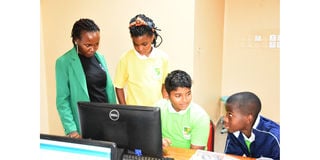Prime
How international curriculum drives literacy development

The new curriculum is solutions-based. PHOTO | FRANK BAGUMA
What you need to know:
- Since 1967, the annual celebrations of International Literacy Day have taken place on September 8, with this year’s celebrations set to be marked under the theme, ‘Promotion of multilingual education: Literacy for mutual understanding and peace’, Joyce Nakato writes.
An international school curriculum offers different ways of learning, picking concepts from different parts of the world to give students a more global outlook.
Programmes such as the International Baccalaureate (IB), Cambridge Assessment International Education (CAIE), and Advanced Placement (AP) have emerged as the most popular. This curriculum is learned and taught in more than 1,000 schools in more than 90 countries.
In Uganda, the international curricula is taught in about 30 education institutions which have taken on the moniker of “international schools.” This included Galaxy International School Uganda, which was established in 2012.
Nestled in the leafy Kampala suburb of Lubowa in Makindye Ssabagabo, Galaxy International School Uganda is one of the premier international schools in Uganda, offering an elite education programme based on the Cambridge International Education Curriculum (CIE).
Students are assessed using the Cambridge primary/lower secondary checkpoint tests, the International General Certificate of Secondary Education (IGCSE) examinations, Cambridge International Advanced Subsidiary levels (AS) and Cambridge International Advanced Levels (A Levels).
Bonita Martha Bwango, the school’s early years coordinator, says in the early years foundation stage, the curriculum centres on seven areas of learning. These include personal, social and emotional development of learning, communication and language, physical development, mathematics, literacy, understanding the world, expressive arts and design.
Foundation stage
“The early foundation stage is a very important aspect because you are laying a foundation for literacy. Equipping young children with literacy skills translates into having people who are able to speak and express themselves clearly and can write without struggling. At this particular stage, we are even able to identify gaps and address them immediately,” she observes.
The National Curriculum Development Centre (NCDC) acknowledges that there has been a vast improvement in the country’s literacy rates in the past years. This, it adds, owes to the different strategies that have been put in place by the government to boost the reading and writing of learners in schools across the country. This includes using local languages to teach literacy at the lower levels of education.
“It has contributed largely to the development of literacy skills in the English language by ensuring that the children learn and practice their language skills in context,” Maureen Nampeera, NCDC’s coordinator of literacy programmes, says of the role the international curriculum plays.
“If you look at it carefully, the curricula draw on the learner’s contextual issues and the children learn from this instead of only cramming grammar and tenses.”
Since it brings into the literacy class the generic skills of critical and creative thinking, effective communication and creativity, a lot can be borrowed from the curriculum.
On what can be borrowed from this curriculum and incorporated into the national curriculum, she points to the area of early childhood learning.
“Time should be set aside, intentionally, to teach the learners how to read and write instead of only concentrating on the thematic content, as is the case in the national schools. Additionally, we need to define learning progression. For example, in Primary One, the child should know how to read and write; in Primary Three, the child should be able to read and write to a certain level,” Nampeera says of what can be incorporated into the national curriculum.
Nampeera adds: “Critically important is the need to look at the idea of multilingualism or bilingualism where children are allowed to speak and express themselves in their languages within the learning context, which will also help us to improve on literacy.”
Learning components
At the primary level, the Cambridge curriculum offers different learning components in the core subjects of Mathematics, English and Science. Special subjects such as art, music, physical education, wellbeing, and computer studies are also offered. Valerie Jean Upshaw, the primary section coordinator, says this promotes literacy by encouraging students to read deeply and engage in critical thinking.
“For example, the Year Five class is learning about proverbs from different parts of the world. This arms them with the ability to innovate and have a cultural awareness,” she says.
Students who are taught under this curriculum can easily enrol into any university across the globe. William Elijah Opong, the school’s lower secondary coordinator, says this is because the curriculum focuses more on the students’ needs.
“International schools have small classes because the learning is quite specific. We have a lot of differentiation so what you teach this year is not what you will necessarily teach the next year. Additionally, the attention you give one child is not the same attention you give to the other child,” he says.
For this curriculum to, however, be successfully implemented, the teaching staff must be highly skilled and trained to deliver it appropriately. All this while keeping up to date with developments in the field of international education.




